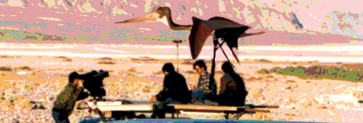By Ray Morgan
The first solar plane we developed at AeroVironment was named the Gossamer Penguin.
The word “gossamer” was an apt description of the appearance of this strange-looking aircraft that had a structural weight of only 54 pounds, with a wing span of 71 feet.
Much was sacrificed to save weight and maximize span, and this presented serious problems when handling the aircraft on the ground. The Penguin was barely strong enough to stay together in the light winds and low turbulence of the early morning. Moving the Penguin back to the hangar at the end of a morning flight was much like walking a 71-foot span kite home from the park.
To move the aircraft about on the ground, as well as to stabilize it during take off and landing, we needed to come up with a lightweight solution. An obvious one would be to assign “wing walkers” to mind each wing tip. A walker would simply pull down on the wing that was being lifted up by the gusts. The tips of the Penguin, however, were over eight feet above the ground. If the aircraft was allowed to tip far enough to one side for ground crew to hold it, then it would have already raised the other tip high into the wind. At that point, the aircraft was likely to flip over.
To solve that problem, we used a string of Kevlar® tied to each tip. It was extremely light and thin, so the performance penalty of carrying the string along in flight was negligible. Unfortunately, this elegantly simple solution had one minor flaw, which, like all such flaws, was discovered the hard way.
When the winds were calm the string worked very well, and kept the wings level and away from the ground. But when a strong wind caught us walking the Penguin home, it required some tension on both strings simultaneously to keep it balanced on the dolly set under the main wheel. Accordingly, the walker would get used to holding the string at a certain height and a certain tension, and when a gust began to lift his wing up, he would feel the increasing tension in the string, and naturally react by pulling down harder on the string.
Sometimes one wing walker would pull down inadvertently, which pulled the opposite wing up slightly. Feeling this tug, the other walker would assume a gust was hitting his wing, and would begin to pull down harder on his wing to prevent the wing from lifting more, and getting even more lift as the wing rose higher against a side gust. The first walker would now feel a strong pull on his wing and would resist even harder. Since the wings weren’t designed to take large point loads near the tips, a disaster seemed imminent.
The fix didn’t require a high-tech solution. After discussing the problem, the flight team realized that by simply having each wing walker alternatively call out an estimate of how hard they were pulling on their string, they wouldn’t fight one another. When the flight team tested the system, they discovered that it didn’t even matter if the walkers’ estimates were accurate; they just needed a rough idea of the balance of their efforts.
In practice, as a pair of walkers got used to working together, they rapidly developed a sixth sense that made their estimates surprisingly close. But this job could quickly get boring, which meant we often changed walkers during a test day. Fortunately, we found that any new team of walkers would quickly calibrate each other after only a short orientation. The result: no broken wings.
The Gossamer Penguin solar-powered aircraft was my first project management experience. Since that time, I’ve found over and over that the most common solution to problems in any group of people that must work together has been better communication. Sometimes it’s a system or process, sometimes it’s an attitude adjustment, but improved communication almost invariably helps a team be more productive and effective. Just as importantly, it generally makes the work a lot more fun.
Search by lesson to find more on:
- Communication
- Teams








